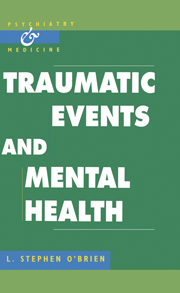Book contents
- Frontmatter
- Contents
- Foreword
- 1 Introduction and historical perspective
- 2 Normal reactions to trauma
- 3 Epidemiology of post-traumatic stress disorder and post-traumatic illness
- 4 Aetiology and predisposing factors
- 5 What constitutes a stressor?
- 6 Post-traumatic illness other than post-traumatic stress disorder
- 7 Diagnosis and assessment
- 8 Management and outcome of post-traumatic illness
- 9 Medicolegal aspects of post-traumatic illness
- 10 Prevention of post-traumatic illness
- 11 The way ahead – whither now?
- Index
4 - Aetiology and predisposing factors
Published online by Cambridge University Press: 05 May 2010
- Frontmatter
- Contents
- Foreword
- 1 Introduction and historical perspective
- 2 Normal reactions to trauma
- 3 Epidemiology of post-traumatic stress disorder and post-traumatic illness
- 4 Aetiology and predisposing factors
- 5 What constitutes a stressor?
- 6 Post-traumatic illness other than post-traumatic stress disorder
- 7 Diagnosis and assessment
- 8 Management and outcome of post-traumatic illness
- 9 Medicolegal aspects of post-traumatic illness
- 10 Prevention of post-traumatic illness
- 11 The way ahead – whither now?
- Index
Summary
At first glance there seems little point in studying the aetiology of PTI. The very definition includes the cause. As Brett and Ostroff (1985) have pointed out, the hypothesis that a unique pattern of symptoms is caused by the experience of extremely stressful events is central to the inclusion of PTSD in the DSM. The threat and feelings of helplessness and vulnerability are thought to be uniquely destabilising of the victim's previous function. PTSD is defined as being the consequence of a traumatic event. In DSM-IV (American Psychiatric Association, 1994), PTSD is one of the few disorders for which the atheoretical approach is abandoned and the definition includes presumed aetiology. It is stated that ‘the essential feature of PTSD is the development of characteristic symptoms following exposure to an extreme traumatic stressor’. In the differential diagnosis section it is recorded that the stressor must be of an extreme (i.e. life-threatening) nature. This is in keeping with the definition in ICD-io (World Health Organisation, 1992).
It seems clear that the aetiology of PTI is connected with trauma, even though Scott (Scott and Stradling, 1994) has suggested that PTSD can occur in the absence of extreme trauma, and there has been serious debate about the necessity or otherwise of the stressor criterion (March, 1993). Breslau and Davis (1987a) have pointed out that there is ‘insufficient data to show that the set of symptoms characteristic of PTSD is strongly and uniquely associated with extraordinary stressors’.
- Type
- Chapter
- Information
- Traumatic Events and Mental Health , pp. 83 - 118Publisher: Cambridge University PressPrint publication year: 1998

